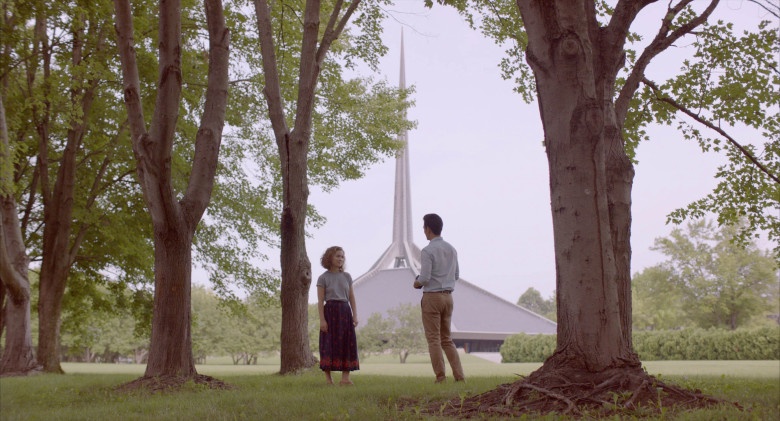A patient, beautiful indie romance set amidst a small town mecca for Modernist architecture.
Sometimes great art requires a little patience. To observe, to reflect, to recognize that what you see at first glance is just that, a first impression of the senses. The more time you spend with it, the more it burrows deep within you, becoming an object of both sensation and thought, a reflection of both form and intention.
Such is the impact of Kogonada’s new indie dramedy Columbus, set in an Indiana city of the same name. Columbus, Ind. is nicknamed the “Athens of the Prairie” for a high concentration of Modernist architecture amidst its otherwise unassuming Midwestern environs.
The movie follows Casey (Haley Lu Richardson), a Columbus native and recent high school graduate who has put off any thoughts of leaving town so that she can live at home and look after her mother. Casey spends her days working part time at the public library, reading, cooking, driving her mom to and from her factory job, and imbibing the city’s architecture, one building at a time.
When she meets Jin (John Cho), a Korean man marooned in Columbus as he waits for his architecture professor father to awake from a coma, Casey begins to question just what her city’s built environment actually means to her.
She knows that these ambitious, experimental churches, gardens, schools, and bridges designed by the likes of Eero Saarinen and Myron Goldsmith are more than just physical backdrops for an ordinary life. And Kogonada, a celebrated video essayist whose previous work has explored the deliberate, highly composed styles of film auteurs like Robert Bresson and Yasujiro Ozu, knows that these buildings are more than just buildings too.

Columbus (2017)
For Casey, these buildings are testaments to the vast imaginative capacity of mankind, and to the close relationship between the external world of art and the internal world that creates and responds to it. The walls of repeating rectangular glass window panes of the Columbus Regional Hospital are soothing calls for stability and calm. The monumental, off-center cross inlaid on the side of the First Christian Church is a reminder of the awe-inspiring beauty of controlled imbalance.
Similarly, for Kogonada, each building is carefully framed by the camera eye to exhibit those same characteristics that so inspire Casey. The two not-quite-touching brick arms of the Columbus City Hall, tantalizingly close to connection, soar beneath the blue sky. The layered, parallel shelves of the Cleo Rogers Memorial Library, shot from above, hint at a labyrinth of knowledge, but also at a home town that may prove inescapable.
As Casey and Jin’s relationship to each other and to the buildings around them progresses, the movie itself moves closer and closer to an understanding that great architecture is great because it inspires careful, sustained observation. Looking at, thinking on, and talking about these buildings over time not only gives life to these artworks; it deepens the self-awareness of those looking.
And therein lies the genius of Columbus, for its patience and attention to its story, characters, and images are not only evident in its treatment of the buildings in this small, unique Indiana city. Rather, that deliberation is evident in every aspect of the movie construction.
Time and time again, Kogonada presents the viewer with brief shots of long passageways: through hallways of homes, along alleys downtown, looking face on across the the cable-stayed Robert N. Stewart Bridge. These lines down the center of the frame draw the viewer’s eyes back and forth, providing a depth to the space and examining how people move through their environments. With joy, concern, ease, indifference. Recurring shots and framings like this create a gentle rhythm that permeates the movie, pulling the audience along with Casey as she figures out what this art means to her, and how she is going to live her life.
In a movie so deeply involved with architecture, the image from Columbus that sticks with me the most is not that of a building at all, but rather a close up of Casey’s face looking out at one.
Early on in the movie, as she leaves the library to wait for her mom to get off work, Kogonada shows her patiently staring back at her workplace, taking in its details and letting their elegance wash over her.
And then the camera jumps suddenly to a few hours later. Her head is in the same position, but now framed by a canopy of leaves. She is still looking out, presumably at another building, but her expression has changed. Teary-eyed, awestruck, unblinking, she appears as if she is having some kind of religious revelation as she looks out at this building. For it reflects a part of her as much as it does a part of her city.
When sitting in the spell of Columbus, it’s difficult not to have the same look.
Columbus is now playing at the Bow Tie Criterion Cinemas in downtown New Haven.